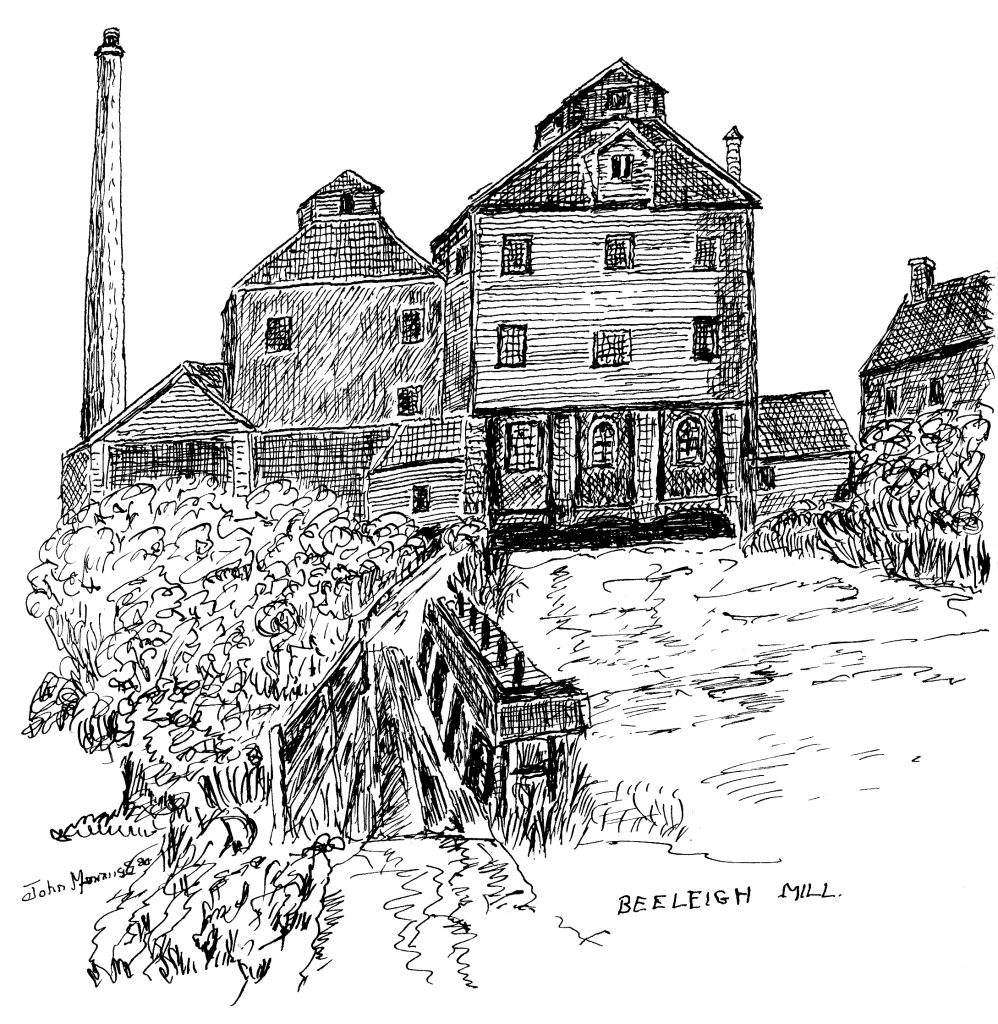| This week’s newsletter is another extract from the writings and sketchbooks of John Munnings (1916-1987), this time on the mills on the river Chelmer, Essex. Many of the mills around Chelmsford were run by members of the Marriage family. Much of my knowledge about this family derives from Llewellen and Samson Marriage, who I used to visit at the Chelmer Mills when collecting 6 ton loads of middlings for my father, bought at Norwich Corn Exchange in the 1930s. Both these members of the Marriage family were real gentlemen. They were usually in the office at 7 am and gave me a welcome cup of tea while their men loaded the lorry for me, something unheard of in those days. |

| The Marriages were a close-knit family who have kept a steady business going for almost 200 years. They were a Huguenot family, Francis Marriage working as a farmer at Stebbing in 1656, the first of many Quakers imprisoned at Colchester Castle. William Marriage, grandson of Francis, milled at Barnes Mill, Chelmsford in the 1760s. When he died in 1824, he left his estate to his twin sons William and Henry, who founded W. & H. Marriage & Sons. Over the next centuries members of the family worked at various watermills in the Chelmsford area. In 1898 or so the firm they bought Bishops Hall mead from the Mildmay estate and built a new steam powered roller mill – Chelmer Mills, which are still operating. Barnes mill remained with the Marriages until 1918 when the Fleming family took it on, running the mill until 1957, after which it became a house. |

| Moulsham Mill, Chelmsford, passed to the Marriage family from I believe the Strutts in 1785. Joseph Marriage (Jnr) built a steam mill behind the watermill; this was rebuilt in about 1890 and had a Simon roller plant installed. This mill was run until the 1970s when the business was transferred to the Chelmer Mills – including the well-known Suffolk millwright, Jesse Whiteman, who was responsible for keeping Saxtead Windmill in good working order. |

MUNN-02-02-080)
| Broomfield Mill, Chelmsford. Marriages took this mill about 1800. In 1836 a S/H Wentworth steam engine was fitted, but it was replaced with a new one in 1852. A plaque bearing the text “W & H M 1836” was later built into the chimney of the Chelmer Mills, which Llewellen Marriage showed me about 1935. |

| Croxton’s Mill, Great Waltham. This was run by John Marriage in 1839. |

| Little Waltham Mill. William Marriage was here in 1800. |

| Springfield Mill, Chelmsford, about the only mill around Chelmsford not run by the Marriage family at any time. There was a century of milling by the Strutt family. George Ling was here before moving to Bishop’s Hall, followed by Alfred Bradbridge who fitted a 40 h.p turbine. |

| Beeleigh Mill, the last mill before the River Chelmer becomes tidal. There was a 13 foot fall at the mill, with three waterwheels over 20 foot in diameter driving twelve pairs of millstones. The adjoining steam mill has five pairs, driven by an 1845 Wentworth engine. Lighters came up the river through the grounds of Beeleigh Abbey and underneath the mill for trading and unloading. The watermill was burned down in 1879. You can find out more about W & H Marriage & Sons on their website: https://flour.co.uk/. |
